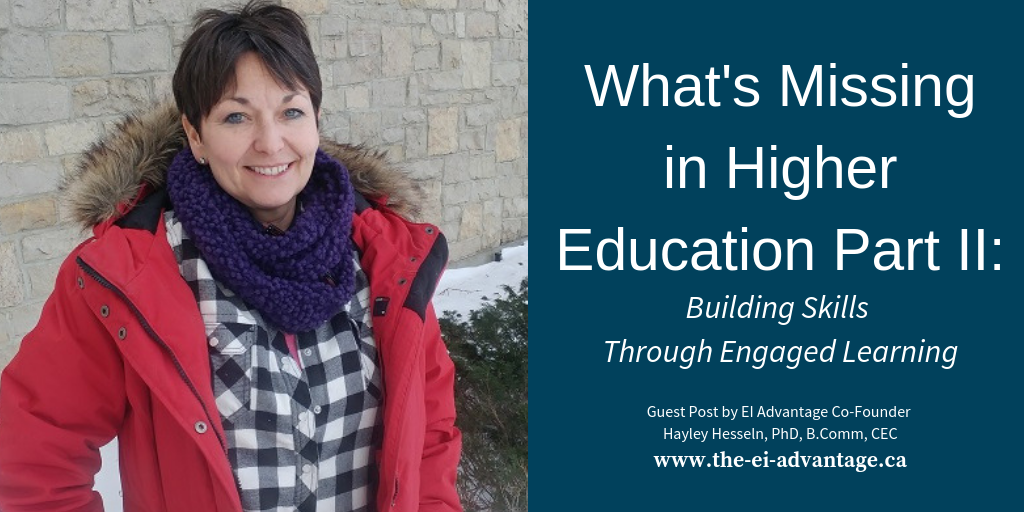Blog
What’s Missing in Higher Education Part II: Building Skills Through Engaged Learning
July 02, 2019

Today, EI ADVANTAGE co-founder Hayley Hesseln, PhD, B.Comm, CEC shares how her experiences in academia and as an Associate Professor at the University of Saskatchewan have influenced her understanding of the importance of “soft skills” like Emotional Intelligence, and what higher learning institutions can do to prepare the next generational workforce for success:
Teaching and… Learning?
I started teaching at the University of Montana in 1996 – it was my first academic job, and I was terrified. I had not been taught how to teach, or anything about pedagogy. My only model was to teach the way I had been taught: prepare lectures, stand at the front of the class and talk for an hour, and prepare and grade exams/assignments. The students were expected to listen to my lectures, take notes, study, and pass exams. Simple.
After a while, it started to occur to me that real learning was not taking place in the classroom, or beyond for that matter.
What is learning? According to Dictionary.com, it is “knowledge acquired by systematic study in any field of scholarly application; the act or process of acquiring knowledge or skill,” and from the field of psychology, “the modification of behavior through practice, training, or experience.”
I began to think about what I learned in my courses. For the most part, I got excellent marks, but not long after I had passed a class, I couldn’t remember what I had learned. Furthermore, I wasn’t sure how to apply the lessons, or why much of the material was important. At this point, I started to investigate new approaches to teaching with a greater focus on the student experience.
Learning and Coaching
Pedagogical research clearly demonstrated more effective ways to teach, and I started to introduce experiential learning into my classes.
Rather than writing an essay and taking a final exam, I had my students troll the news for current events. They are expected to learn the theory, identify how the principles can be applied, and enhance their knowledge about the world around them. The focus is now on application and synthesis of ideas using discussion, rather than memorization and test taking.
At about the same time, I was changing my approach to teaching, I also took the executive coaching program at Royal Roads University.
The coach approach I learned was based on a model called “Excellerator,” which followed a logical progression: engage, enlighten, empower, and excel.
Engage with the client by listening to what they say and how they feel. Enlighten the client through curiosity and inquiry to help them see new perspectives. Empower the client by helping them overcome barriers and to embrace challenges. Finally, help them excel in achieving their goals.
This model was incredibly profound to me. This was what I had been doing in my classrooms to promote deeper learning! While I hadn’t been able to articulate the steps, it became apparent that I was using a coaching model to teach. More importantly, the model was working.
My New Approach
Engaging with the students meant that I listened to them about their reasons for being in university, their interests in the subject matter, and what they wanted to do with their lives. By listening, I learned that they too found some of their classes pointless and not useful in preparation for jobs or higher learning. My job then became to make the material I taught relevant and to help them apply what they learned to their own lives.
When coaching, we ask our clients many questions that are designed to help them see things differently. True to the definition of learning above, they are then able to see different perspectives and change behaviours.
Teaching is the same – I focus on enlightening students by getting them to see both sides of an issue through engaged debate. While it is uncomfortable, students report that they learned to be critical and more open-minded.
Empowerment provides all individuals with the skills and tools necessary to succeed. In higher education, this means equipping students with the ability to confidently articulate their thoughts, to think critically, and to communicate in a way the promotes collaboration. The end result is that they excel.
What Does It Mean?
All of my courses are now designed using a coach approach to teaching with an emphasis on life-long and self-guided learning. I have greatly reduced my role as the “talking head,” and now focus on facilitating discovery through questions, critical thinking and engaged debate, group discussion, and collaboration.
Anonymous student reviews strongly support the new model in spite of it being unfamiliar to them, and for requiring active engagement and preparation. Students also report that they are now accountable for their own learning and that they know better “how” to learn. This is music to my ears.
Contact us today or reach out on Facebook, LinkedIn, or Twitter.
